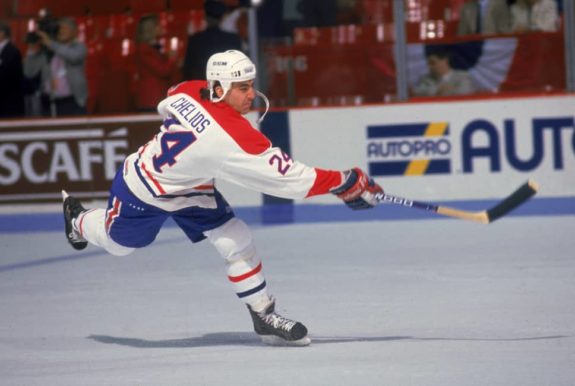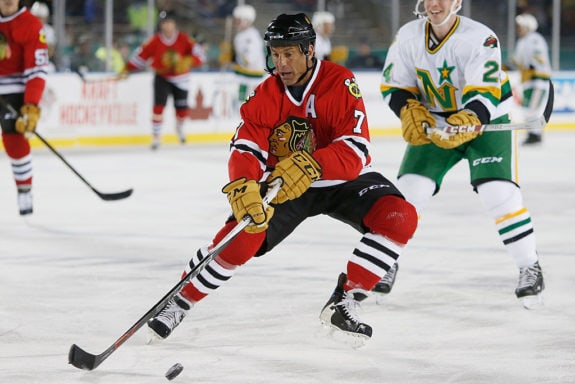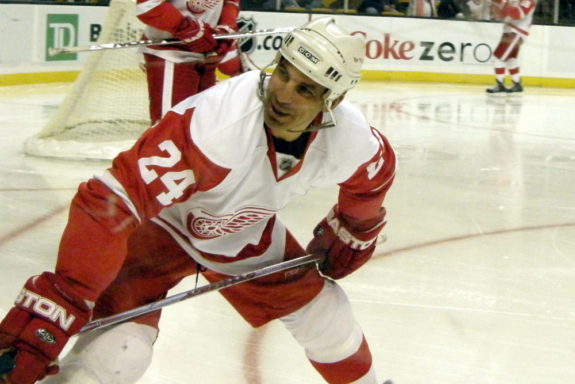For nine years, Hall of Fame defenseman Chris Chelios was one of the most beloved players in Chicago Blackhawks history. He fell out of favor with Blackhawks fans shortly after he was traded to the hated Detroit Red Wings, but time has healed those wounds. Chelios was back to the organization as an ambassador in July 2018 and he will be forever remembered as one of the best defensemen in franchise history.
2 Legends Are Traded for Each Other
Long before trading P.K. Subban for Shea Weber, the Montreal Canadiens made a huge trade with the Blackhawks on June 29, 1990. The Habs sent a then 28-year-old Chelios and a second-round draft pick (Michael Pomichter) to Chicago for fan-favorite Denis Savard. This was a rare trade that involved two popular and established stars being dealt for each other.
Savard had seven seasons of at least 32 goals already under his belt and was the dynamic center the Canadiens were looking for. However, his final two seasons in Chicago were marred by injury which caused a major dip in production. He scored a combined 50 goals during the 1988-89 and 1989-90 seasons while missing a total of 42 games.

Chelios had established himself as one of the top defensemen in the game by the time he was traded to his hometown. He won the first of three Norris Trophies in 1989, played in one All-Star Game and was a key contributor to the Canadiens’ 1986 Stanley Cup win. Much like Savard, Chelios missed 27 games due to injury during his final year in Montreal.
Even though Chelios had been a major factor in two runs to the Stanley Cup Final in Montreal, the Canadiens were ready to move on. Upper management did not feel that he fit the mold of the Canadiens tradition. In fact, Chelios and future defensive partner Gary Suter were arrested in Madison, WI for getting into a fight with police less than 48 hours after the trade was made with the Blackhawks. The off-ice issues did not scare off the Blackhawks and they reaped the rewards for the next nine seasons.
Blackhawks Win Trade with Canadiens
There is no doubt that the Blackhawks got the better end of the Chelios-for-Savard trade. Savard had a productive three-year stint with the Canadiens, including 72 goals and 179 points in 210 games, but he was far from the elite goalscorer he was prior to his arrival. He had five assists during the Canadiens’ 1993 run to their 24th Stanley Cup win in franchise history. He signed with the Tampa Bay Lightning in 1993 and was traded back to the Blackhawks for a sixth-round pick during the 1994-95 season. Savard played two more seasons with the Blackhawks and Chelios before retiring in 1997.
Meanwhile, Chelios wasted no time endearing himself in the Windy City. He was the first homegrown star the Blackhawks had and he personified the blue-collar image of Chicago. Not only was he one of the best all-around defensemen in the game, but he was also one of the toughest players to ever put on the iconic Blackhawks sweater.
While Savard was not living up to expectations in Montreal, Chelios was exceeding them in Chicago. He picked up 55 assists in his first season with the Blackhawks and had a huge role in the Blackhawks 1992 run to the Stanley Cup Final, their first Final appearance since 1973. He had six goals, 21 points and was a plus-19 during that magical spring. The following season, he went on to win his first of two Norris Trophies while playing for the Blackhawks.
In 1995, Chelios closed out the Vancouver Canucks season and the Pacific Coliseum with overtime goals in back-to-back playoff games.
The 1995-96 season saw the Blackhawks lose in six games to the Colorado Avalanche in the second round of the Stanley Cup playoffs. The memorable series featured seven periods of overtime as the Blackhawks pushed the eventual Stanley Cup champs to the limit. That was the last great Blackhawks team for well over a decade.
Trades Bring the Dark Days
During the summer of 1996, the Blackhawks traded star Jeremy Roenick to the Phoenix Coyotes for Alex Zhamnov, Craig Mills and a first-round pick that was used to select Ty Jones. The following January, two-time Vezina Trophy-winning goaltender Ed Belfour was shipped to the San Jose Sharks for Chris Terreri, Ulf Dahlen, and Michal Sykora.
With the team gutted because owner Bill Wirtz did not want to pay his top stars market value, the Blackhawks struggled mightily during the 1998-99 season and the writing was on the wall that Chelios would be the next player on his way out.

“I want to stay in Chicago. I don’t know how I can put it simpler,” Chelios told the Chicago Tribune in Jan. 1999. “Things are going bad here, but I’m not the type of player who is going to quit or ask to be traded. My heart is in Chicago and it’s always going to be in Chicago.”
According to his book Made In America, Chelios reached out to Wirtz’s lawyer about working out a contract extension to remain with the Blackhawks after his contract expired following the 1999-00 season. After weeks went by without a response, the veteran defender demanded a trade out of Chicago.
On March 23, 1999, the Blackhawks made one of the worst trades in franchise history by shipping Chelios to Detroit for Anders Eriksson and first-round picks in both 1999 and 2001. Eriksson played just 97 games for the Blackhawks before being traded to the Florida Panthers for Jaroslav Spacek in Nov. 2000. The two draft picks turned into Steve McCarthy and Adam Munro, who combined for 151 NHL games for the Blackhawks. Munro played in just 17 career games; a pretty brutal return for a great player who proved to have plenty left in his tank.

Chelios went on to play in 578 games over the next decade in Detroit. His best season came in 2001-02 when he had six goals, 39 points, and a plus-40 rating while averaging over 25 minutes a game at age 40. He narrowly finished second in Norris voting behind his teammate Nicklas Lidstrom. He picked up 14 assists during the 2002 postseason, which ended with a championship. Chelios got his name engraved on the Stanley Cup for the third time in 2008.
At 47 years old, Chelios played in one final professional season in 2009-10 with the Chicago Wolves in the American Hockey League and seven NHL games with the Atlanta Thrashers. He announced his retirement on Aug. 31, 2010, and was hired by the Red Wings as an Adviser to Hockey Operations, with the role of working with the team’s defensive prospects in the AHL.
Chelios Deserves His Number in the Rafters
During the ’90s, whether it was the Chicago Stadium or United Center, the seats were full of fans with the No. 7 on their backs. Once Chelios wore the hated winged wheel on his chest, the hometown fans quickly turned on him. It was not easy to watch one of your favorite players lead your biggest rival to the glory you wish he had achieved with the Blackhawks.
In July 2018, Chelios announced that he was leaving the Red Wings organization to move back to Chicago to be closer to his mother and family. The Blackhawks were quick to bring him back into the fold by naming him as an Ambassador.
“To be able to join the Blackhawks organization in this role means everything to me,” Chelios said in an official statement. “I’m very thankful to Rocky Wirtz and John McDonough for this opportunity to return to the Blackhawks. Chicago is my hometown, and returning to this organization is very special to me and my family.”
You may also like:
- Blackhawks Sign Alex Vlasic to 6-year Contract Extension
- Chicago Blackhawks 2023-24 Player Grades: Defense
- Chicago Blackhawks’ 2023-24 Player Grades: Forwards
- Blackhawks: Highs and Lows of the 2023-24 Season
- Blackhawks’ Worst Trades of All-Time
It took a large portion of Blackhawks fans quite some time to get over Chelios’ days with the Red Wings and there are those who still haven’t let it go. Even if he did win a pair of Stanley Cups with Detroit, he will always be one of the greatest players to ever wear a Blackhawks sweater.
In his nine seasons in Chicago, he represented the Blackhawks in seven NHL All-Star Games. He was a finalist for the Norris Trophy four times, winning it twice. He was the heart and soul of the Blackhawks during one of their most successful eras in team history by leading them to seven straight trips to the Stanley Cup playoffs.
All it takes is just a quick look through the Blackhawks record book to see how great Chelios was in red and black. He is still 10th all-time with 395 assists, which is fourth among defensemen. His 0.59 assists per game are the most by any defenseman in team history and eighth overall. He was on the ice for 1,122 goals for, 452 of those on the power play, and 881 goals against. Chelios holds the franchise record for penalty minutes with 1,495, a tally that may never be surpassed.
While he has the numbers to back up his induction into the Hockey Hall of Fame, it was never just about stats for Chelios. He was the ultimate teammate and leader. He never backed down from an opposing player. If there was a time when a teammate needed to be defended, he was the first to stand up for him. When there was a post-whistle scrum, you could always bet that Chelios was right in the middle of it. He had world-class skill, but always played with an edge and was not afraid to cross the line when he had to.
The Blackhawks are a team that has produced some of the best defensemen the game has ever seen and Chelios is right at the top of that list. He is arguably the best American-born blueliner and is in the team photo for the top players the country has ever produced.
The Blackhawks will likely wait for Brent Seabrook to honor both of the all-time greats as they did for Pierre Pilote and Keith Magnuson. But there is little doubt that his No. 7 will be hanging from the United Center rafters one day.
